Het maakt niet uit of u macOS, Windows 10 of Windows 11 gebruikt. Het is slechts een kwestie van tijd totdat uw computer weigert op te starten, wat om vele redenen kan gebeuren, waaronder bestandscorruptie, hardwarestoringen en een foutieve update.
Als het onverwachte gebeurt met een Apple-computer, kunt u een macOS opstartbare USB gebruiken met de installatiemedia om het te repareren.
Dit is een van de belangrijkste redenen waarom u zou moeten overwegen een macOS opstartbare USB te maken als uw apparaat goed werkt.
Meld u dan aan voor onze nieuwsbrief.
Als echter geen van uw apparaten (MacBook, MacBook Air, MacBook Pro, iMac, Mac Pro, of Mac Mini) werkt wanneer u ze het meest nodig hebt, kunt u een Windows-computer gebruiken om uw Apple apparaat te herstellen.
U kunt een Windows 10 of Windows 11, Windows 8.1 of Windows 7 computer gebruiken om een opstartbaar installatiemedium op USB te maken waarmee u macOS Monterey, Big Sur of Catalina opnieuw op uw Mac kunt installeren.
macOS installatie USB maken in Windows 11 of Windows 10
Om te beginnen dient u software te downloaden en installeren. Dit is de TransMac software. TransMac is betaalde software, maar gratis te gebruiken voor 15 dagen in een volledig functionele testversie.
Wat u ook nodig heeft is macOS installatiemedia zoals een ISO-bestand of DMG-bestand. Deze kunt u op verschillende plaatsen downloaden op het internet.
Na installatie van TransMac klik met de rechtermuisknop op de gevonden USB stick in de lijst van apparaten. Zorg dat uw USB stick wordt herkend in Windows.
Klik daarna op “Format Disk for Mac”. U gaat nu de USB disk formatteren, dus alle data op de USB stick gaat verloren.
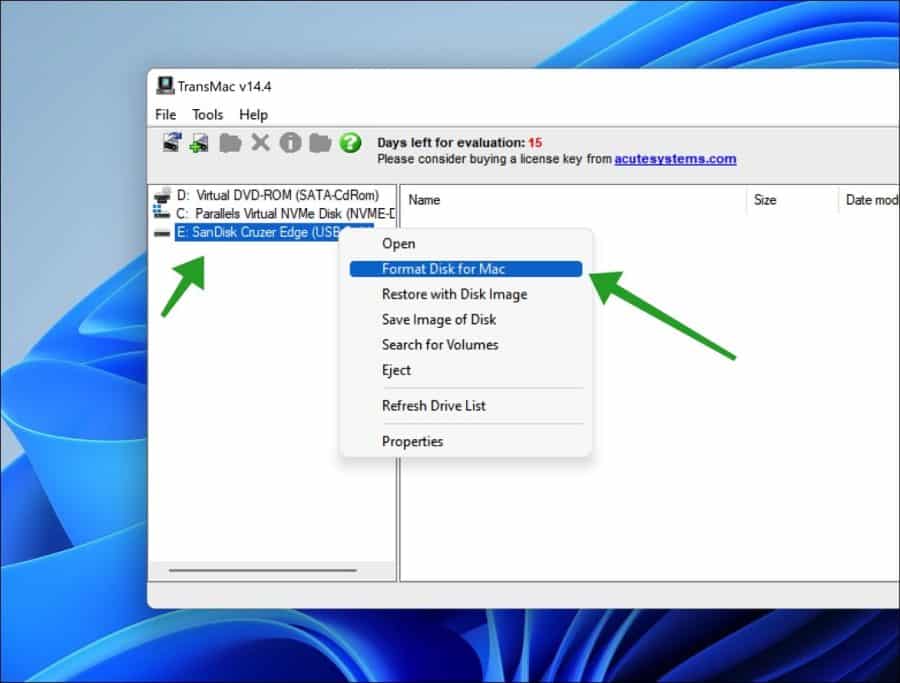
Geef een duidelijke herkenbare volume naam in voor de USB stick. Klik op OK.
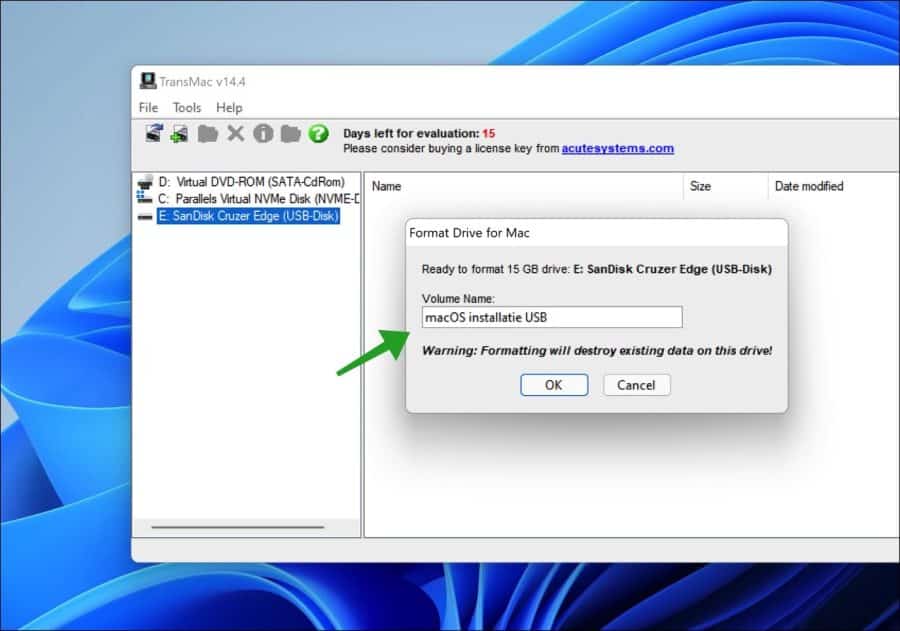
Als dit proces klaar is, klik met de rechtermuisknop op de USB stick en klik op “Restore with Disk Image”. U gaat nu het ISO/DMG-bestand plaatsen op de USB stick.
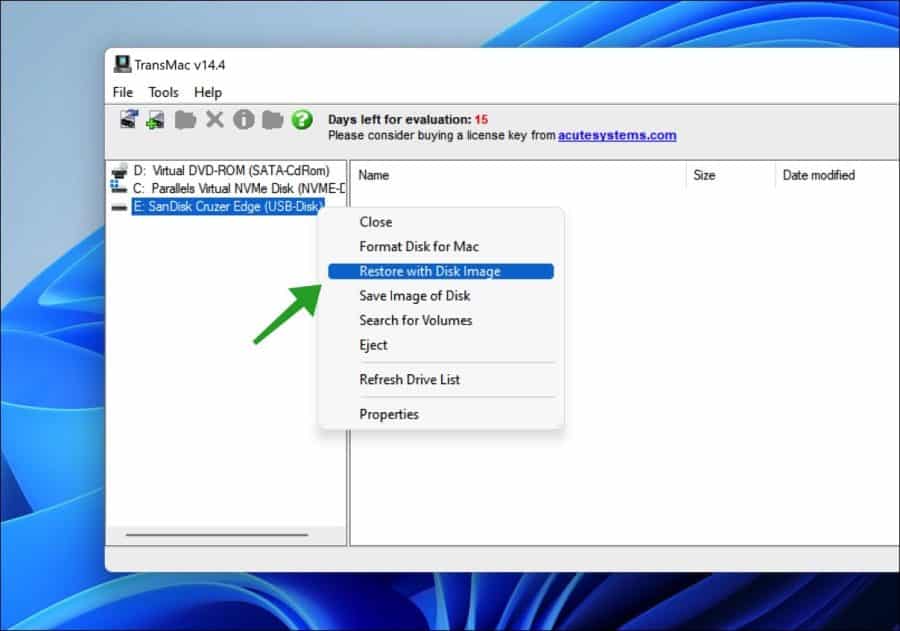
Selecteer het Disk image bestand en klik op OK. Nogmaals alle data op de USB stick gaat verloren.
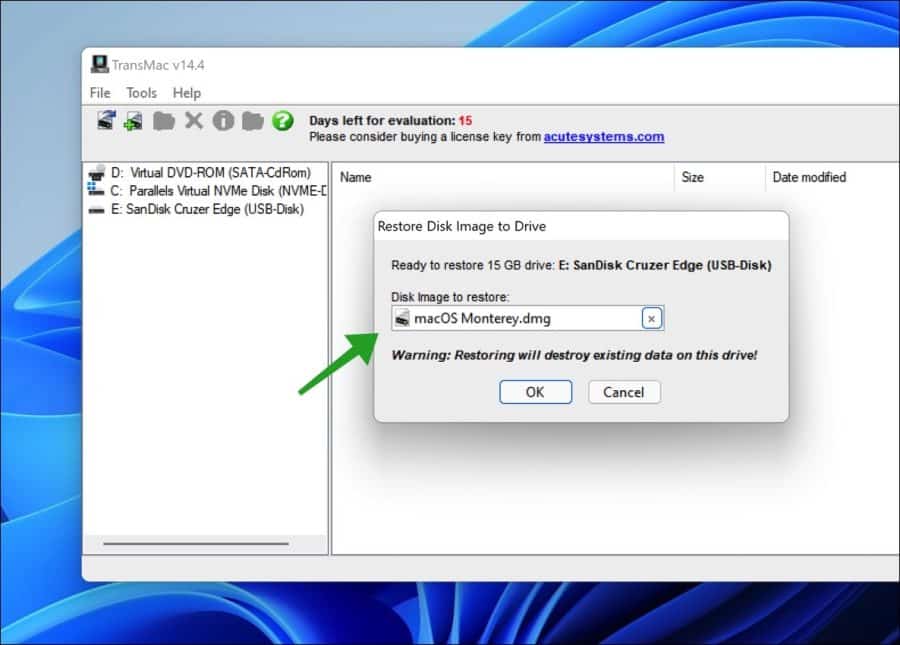
Als u door wilt gaan met het aanmaken van de installatie USB voor macOS dan bevestigd u met Yes.
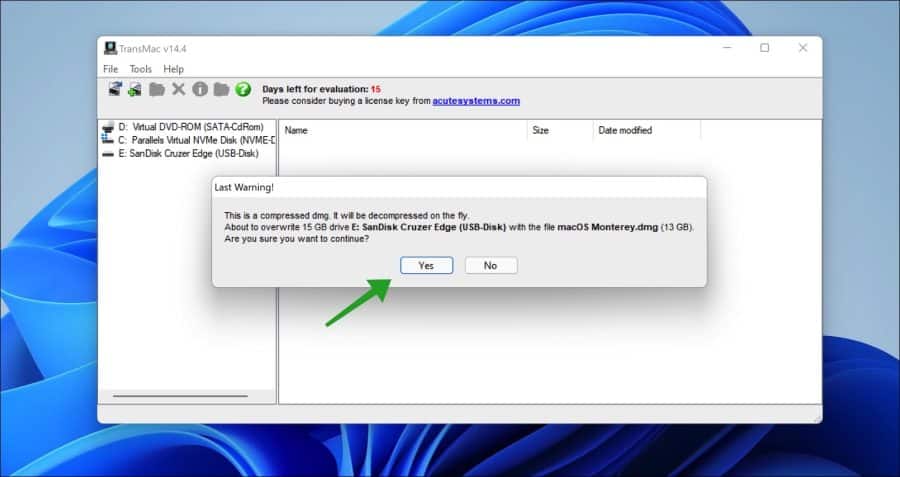
De installatie USB wordt nu aangemaakt. Dit kan even duren, eerst wordt de USB stick geformatteerd en daarna wordt de macOS installatiemedia erop geplaatst.
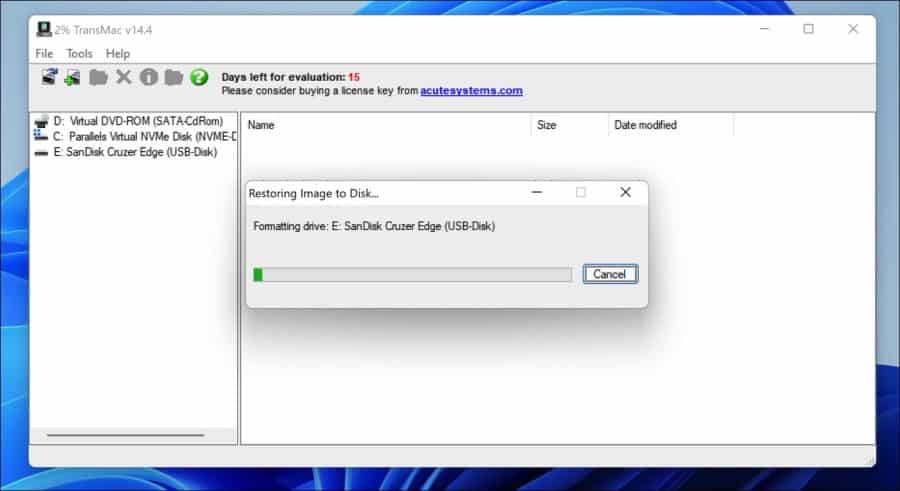
Zodra u de stappen hebt voltooid, kunt u nu de USB stick in uw Mac computer plaatsen om het besturingssysteem te installeren, opnieuw te installeren of te upgraden naar de nieuwste macOS versie, Sierra, Catalina, Big Sur, Monterey of een andere versie.
Om uw Mac op te starten vanaf de zojuist aangemaakte USB stick voert u het volgende uit:
Plaats het USB opstartmedium in een open USB slot. Druk op de aan/uit-knop om uw Mac aan te zetten (of herstart uw Mac als deze al aan staat). Wanneer u het opstartgeluid hoort, houdt u de (Option ⌥ toets) ingedrukt.
Als u die toets ingedrukt houdt, krijgt u toegang tot Opstartbeheer. Zodra Opstartbeheer verschijnt, laat u de (Option ⌥ toets) los. Het hulpprogramma zoekt naar beschikbare schijven die opstartbare inhoud bevatten.
Selecteer met de aanwijzer of de pijltjestoetsen op het toetsenbord de USB stick waarvan u wilt opstarten. Eenmaal geselecteerd, dubbelklikt u op uw de selectie. Uw Mac start nu op vanaf het USB station.
Als u meerdere USB apparaten heeft gekoppeld, geen probleem. Uw Mac selecteert zelf de USB met opstartmedia.
Lees ook:
- Opstartbare (Bootable) Linux USB stick aanmaken.
- Windows 11 installeren vanaf USB.
- Windows 10 installeren vanaf USB.
- Windows 11 installeren op oude PC.
Ik hoop u hiermee geholpen te hebben. Bedankt voor het lezen!

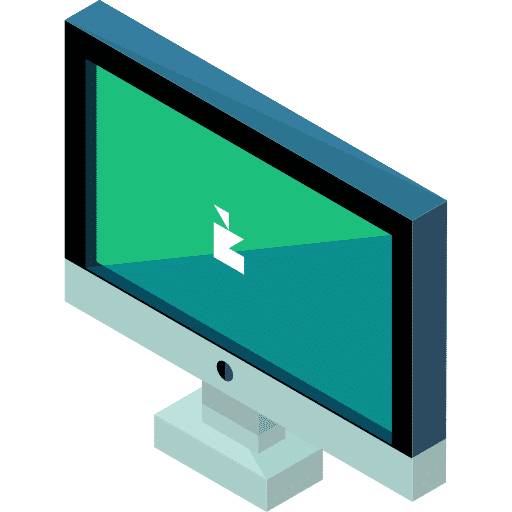
Ongeveer een week geleden duurde het wel 10 minuten, voordat de pc opstartte. Echter, na enkele pogingen ging dat weer goed. Waarom de pc zo haperde, weet ik niet. Ik heb een recovery gebruikt, waardoor Windows, met behoud van bestanden, het weer deed. Toch heb ik sindsdien, bijv. als ik een spel speel, dat bij het schuiven van de muisaanwijzer, het beeld dan wegvalt. Ik heb gekeken naar de DLL bestanden, maar dat is ondoenlijk, want Windows heeft eindeloos veel DLL files. Kortom, bij de recovery is dus iets fout gegaan, maar waar die fout zit, weet ik niet. Ik hoop, dat mijn vraag duidelijk is. Alvast bedankt voor je hulp.
Hallo, recovery of herstel zet alle bestanden, apps en instellingen terug. Hier gaat over het algemeen niets mis, maar ik vermoed dat er software is teruggezet die conflicteert. Controleer uw apps en verwijder alle apps die u niet nodig heeft. Herstart ook de PC als u dit nog niet had gedaan. Als het nog niet opgelost is, raad aan om de stuurprogramma’s voor de videokaart opnieuw te installeren. Afhankelijk van het merk/model videokaart downloadt u de nieuwste drivers (stuurprogramma’s) en installeert u deze opnieuw.
https://support.microsoft.com/nl-nl/windows/stuurprogramma-s-handmatig-bijwerken-in-windows-ec62f46c-ff14-c91d-eead-d7126dc1f7b6Succes!
Het is ook een dmg bestand.
Maar goed, die link van u had ik zelf ook al een paar keer bekeken.
Ik denk dat het een gevalletje archief (vuilcontainer) wordt.
Bedankt voor de info
U kunt er altijd nog Linux op installeren. Dat werkt prima is mijn ervaring, mogelijk leuk om mee te experimenteren.
https://www.pc-tips.info/tips/linux/opstartbare-bootable-linux-usb-stick/
Gebruik dezelfde toetsencombinatie om op te starten vanaf de aangemaakte opstartbare Linux USB.
Groet, Stefan
Het lukt mij niet om een bootable USB stick te maken vanuit Windows.
Het stappenplan zoals u omschrijft tig keer uitgevoerd, maar als ik op mijn Windows laptop de USB opnieuw erin stopt vraagt hij of de USB stick geformatteerd moet worden. Er staat dan niets op.
Ik ben in het bezit van een Macbook. Een krijgertje waarvan het wachtwoord van zijn apple ID gewijzigd was in zijn nieuwe Macbook waardoor deze niet meer toegankelijk was om wijzigingen uit te voeren.
Samen met Apple Support de HD gewist en getracht een nieuwe Yosemite erop te installeren, maar de App store kent deze Yosemite niet meer.
Via via Yosemite gedownload, maar daarvoor moet ik dus een bootable USB stick maken met Yosemite.
Wellicht kunt u mij op een andere manier hiermee helpen en kunt u een bootable USB stick met Yosemite voor mij maken tegen betaling.
Graag verneem ik uw reactie.
Mvgr,
Clement Berkhout
Hallo, kunt u mij aangeven wat er precies niet lukt met het aanmaken van de USB in Windows? De format kunt u gewoon uitvoeren, de rest van de stappen bij het aanmaken zouden ook moeten lukken. Ik zie even niet waar u precies vastloopt? Zorg dat u een officiële macOS Yosemite image gebruikt.
Groet, Stefan
In principe geeft TransMac aan dat hij klaar is.
Als ik hem dan in de Macbook doe wordt hij niet gezien.
Ik kan op mijn Windows laptop niet controleren of er iets op staat.
Daarop heb ik het denk ik wel 6 keer opnieuw uitgevoerd
Hallo, het is belangrijk dat u de juist “image” gebruikt. Dat is een iso of dmg bestand. Daarnaast zorg dat u opstart vanaf USB door een toetsencombinatie zoals beschreven in het artikel. Uw Macbook start niet zelf vanaf USB, daar is een toetsencombinatie voor nodig. Ik kan het niet nabootsen omdat het om een oude Macbook gaat en om Yosemite. Ik vermoed dat de image niet goed is en daarom niet wordt gestart. U geeft ook aan dat de USB leeg is nadat u 6x de instructie heeft gevolgd, dit bevestigd mijn vermoeden.
Hier leest u hoe u een oude versie van macOS kunt downloaden.
https://support.apple.com/nl-nl/HT211683 Dit DMG bestand (onderaan de pagina voor Yosemite) kunt u mogelijk gebruiken om de image aan te maken op USB. Succes! Groet, Stefan